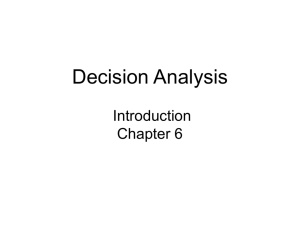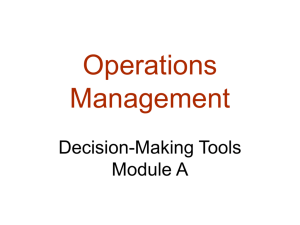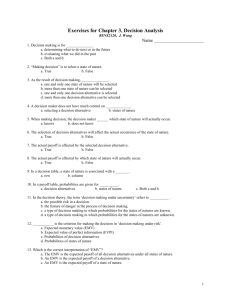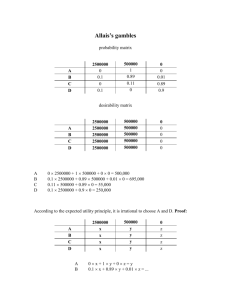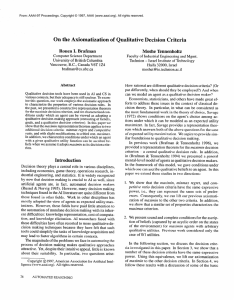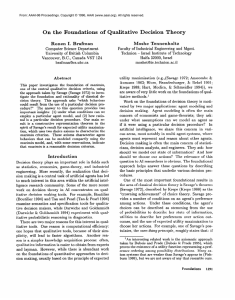MGS3100_Slides8a
advertisement
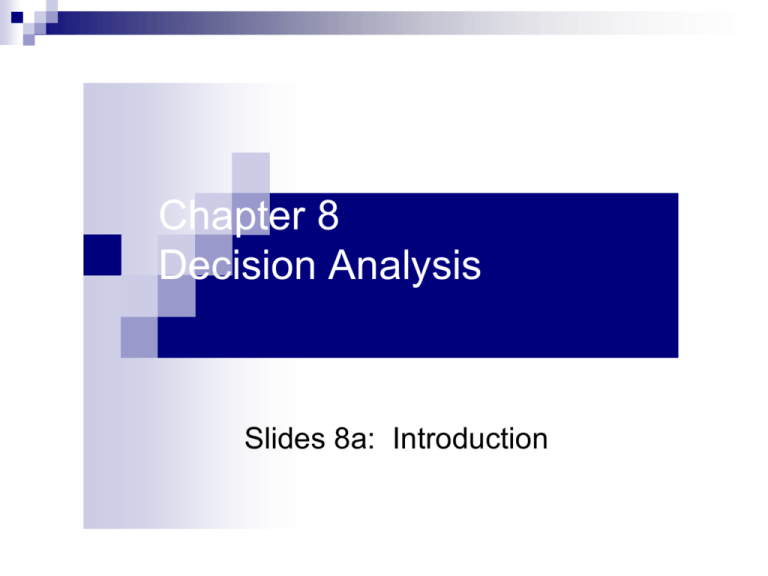
Chapter 8
Decision Analysis
Slides 8a: Introduction
Decision Analysis
A set of alternative actions
We
may chose whichever we please
A set of possible states of nature
Only
one will be correct, but we don’t know in
advance
A set of outcomes and a value for each
Each
is a combination of an alternative action and a
state of nature
Value can be monetary or otherwise
Decision Analysis
Certainty
Decision
Maker knows with certainty what the state of
nature will be - only one possible state of nature
Ignorance
Decision
Maker knows all possible states of nature,
but does not know probability of occurrence
Risk
Decision
Maker knows all possible states of nature,
and can assign probability of occurrence for each
state
Decision Making Under Certainty
Decision Variable
Units to build
Parameter Estimates
Cost to build (/unit)
Revenue (/unit)
Demand (units)
150
$
$
6,000
14,000
250
Consequence Variables
Total Revenue
Total Cost
$ 2,100,000
$ 900,000
Performance Measure
Net Revenue
$ 1,200,000
Decision Making Under Ignorance
– Payoff Table
Kelly Construction Payoff Table (Prob. 8-17)
State of Nature
Demand
Alternative
Actions Low (50 units) Medium (100 units) High (150 units)
Build 50
400,000
400,000
400,000
Build 100
100,000
800,000
800,000
Build 150
(200,000)
500,000
1,200,000
Decision Making Under Ignorance
Maximax
Select the strategy with the highest possible
return
Maximin
Select the strategy with the smallest possible
loss
LaPlace-Bayes
All states of nature are equally likely to occur.
Select alternative with best average payoff
Maximax:
The Optimistic Point of View
Select the “best of the best” strategy
Evaluates
each decision by the maximum possible
return associated with that decision (Note: if cost data
is used, the minimum return is “best”)
The decision that yields the maximum of these
maximum returns (maximax) is then selected
For “risk takers”
Doesn’t
consider the “down side” risk
Ignores the possible losses from the selected
alternative
Maximax Example
Kelly Construction
State of Nature
Alternative
Actions
Demand
Maximax
Criterion
Low (50 units) Medium (100 units) High (150 units)
Max
Build 50
400,000
400,000
400,000
400,000
Build 100
100,000
800,000
800,000
800,000
Build 150
(200,000)
500,000
1,200,000
1,200,000
Maximin:
The Pessimistic Point of View
Select the “best of the worst” strategy
Evaluates
each decision by the minimum
possible return associated with the decision
The decision that yields the maximum value
of the minimum returns (maximin) is selected
For “risk averse” decision makers
A “protect”
strategy
Worst case scenario the focus
Maximin
Kelly Construction
State of Nature
Alternative
Actions
Demand
Maximin
Criterion
Low (50 units) Medium (100 units) High (150 units)
Min
Build 50
400,000
400,000
400,000
400,000
Build 100
100,000
800,000
800,000
100,000
Build 150
(200,000)
500,000
1,200,000
(200,000)
Decision Making Under Risk
Expected Return (ER)*
Select
the alternative with the highest (long term)
expected return
A weighted
average of the possible returns for
each alternative, with the probabilities used as
weights
* Also referred to as Expected Value (EV) or Expected
Monetary Value (EMV)
**Note that this amount will not be obtained in the short
term, or if the decision is a one-time event!
Expected Return
State of Nature
Alternative
Actions
Demand
Expected
Return
Low (50 units) Medium (100 units) High (150 units)
ER
Build 50
400,000
400,000
400,000
400,000
Build 100
100,000
800,000
800,000
660,000
Build 150
(200,000)
500,000
1,200,000
570,000
0.5
0.3
1.0
Probability
0.2
Expected Value of Perfect Information
EVPI measures how much better you could do on
this decision if you could always know when each
state of nature would occur, where:
EVUPI
= Expected Value Under Perfect Information
(also called EVwPI, the EV with perfect information, or
EVC, the EV “under certainty”)
EVUII
= Expected Value of the best action with
imperfect information (also called EVBest )
EVPI
= EVUPI – EVUII
EVPI tells you how much you are willing to pay for
perfect information (or is the upper limit for what you
would pay for additional “imperfect” information!)
Expected Value of Perfect
Information
State of Nature
Alternative
Actions
Demand
Expected
Return
Low (50 units) Medium (100 units) High (150 units)
ER
Build 50
400,000
400,000
400,000
400,000
Build 100
100,000
800,000
800,000
660,000
Build 150
(200,000)
500,000
1,200,000
570,000
0.2
0.5
0.3
1.0
400,000
800,000
1,200,000
840,000
EVPI
180,000
Probability
Best Decision
Using Excel to Calculate EVPI:
Formulas View
Kelly Construction
A
1
2
3
4
5
6
7
8
9
10
11
12
13
14
Payoffs
Alternatives
Build 50
Build 100
Build 150
Probability
Best Decision
B
C
States of Nature
Low (50 units) Medium (100 units)
400000
400000
100000
800000
-200000
500000
0.2
0.5
=MAX(B5:B7)
=MAX(C5:C7)
D
E
Expected Return
High (150 units)
ER
400000
=SUMPRODUCT(B5:D5,B$8:D$8)
800000
=SUMPRODUCT(B6:D6,B$8:D$8)
1200000
=SUMPRODUCT(B7:D7,B$8:D$8)
0.3
=MAX(D5:D7)
EVwPI = =SUMPRODUCT(B9:D9,B8:D8)
EVBest = =MAX(E5:E7)
EVPI = =E11-E12
The Newsvendor Model
A newsvendor can buy the Wall Street Journal
newspapers for 40 cents each and sell them for 75
cents.
However, he must buy the papers before he knows
how many he can actually sell. If he buys more
papers than he can sell, he disposes of the excess at
no additional cost. If he does not buy enough
papers, he loses potential sales now and possibly in
the future.
Suppose that the loss of future sales is captured by a
loss of goodwill cost of 50 cents per unsatisfied
customer.
The demand distribution is as follows:
P0 = Prob{demand = 0} = 0.1
P1 = Prob{demand = 1} = 0.3
P2 = Prob{demand = 2} = 0.4
P3 = Prob{demand = 3} = 0.2
Each of these four values represent the states of
nature. The number of papers ordered is the decision.
The returns or payoffs are as follows:
Decision
State of Nature (Demand)
0
1
2
3
0
0
-50
-100
-150
1
-40
35
-15
-65
2
-80
-5
70
20
3
-120
-45
30
105
Payoff = 75(# papers sold) –
40(# papers ordered) – 50(unmet demand)
Where 75¢ = selling price
40¢ = cost of buying a paper
50¢ = cost of loss of goodwill
Now, the ER is calculated for each decision:
ER0 = 0(0.1) – 50(0.3) – 100(0.4) – 150(0.2) = -85
ER1 = -40(0.1) + 35(0.3) – 15(0.4) – 65(0.2) = -12.5
ER2 = -80(0.1) – 5(0.3) + 70(0.4) + 20(0.2) = 22.5
ER3 = -120(0.1) – 45(0.3) + 30(0.4) – 105(0.2) = 7.5
State of Nature (Demand)
Decision
0
1
0
1
2
0
-50 ER’s,
-100
Of these
four
-40 the maximum,
35
-15
choose
2
-80
3
Prob.
3
ER
-150
-85
-65
-12.5
-5
70
20
22.5
-120
-45
30
105
7.5
0.1
0.3
0.4
0.2
and order 2 papers
State of Nature
Decision
0
1
2
0
0
-50
-100
-150
1
-40
35
-15
-65
2
-80
-5
70
20
3
-120
-45
30
105
0.1
0.3
0.4
0.2
Prob.
3
ER(new) = 0(0.1) + 35(0.3) + 70(0.4) + 105(0.2)
= 59.5
ER(current) = 22.5
EVPI = 59.5 – 22.5 = 37.0 cents
Maximax Criterion: The Maximax criterion is an
optimistic decision making criterion.
This method evaluates each decision by the maximum
possible return associated with that decision.
The decision that yields the maximum of these maximum
returns (maximax) is then selected.
Maximin Criterion: The Maximin criterion is an
extremely conservative, or pessimistic, approach to
making decisions.
Maximin evaluates each decision by the minimum possible
return associated with the decision.
Then, the decision that yields the maximum value of the
minimum returns (maximin) is selected.
So, using the 3 criteria, we made the following
decisions regarding the newsvendor data:
Criteria
Decision
Maximin Cash Flow
Order 1 paper
Expected Return
Order 2 papers
Maximax Cash Flow
Order 3 papers
THE RATIONALE FOR UTILITY
Most people are risk-averse, which means they
would feel that the loss of a certain amount of
money would be more painful than the gain of
the same amount of money.
Utility functions in decision analysis measure the
“attractiveness” of money.
Utility can be thought of as a measure of
“satisfaction.”
Typical risk-averse utility function:
A gain
in
utility
of 0.06
Utility
1.0
0.910
0.850
0.775
0.680
0.524
100
200
300
400
500
600 Dollars
Go from $400 to
$500 results in
To illustrate, first suppose you have $100 and someone
gives you an additional $100. Note that your utility
increases by
U(200) – U(100) = 0.680 – 0.524 = 0.156
Now suppose you start with $400 and someone gives you
an additional $100. Now your utility increases by
U(500) – U(400) = 0.910 – 0.850 = 0.060
This illustrates that an additional $100 is less attractive if
you have $400 on hand than it is if you start with $100.
Utilities and Decisions under Risk
Summary:
Utility is a way to incorporate risk aversion into the
expected return calculation.
Calculating a utility function is out of the scope of
this course, but it can be calculated by a series of
lottery questions (e.g., Would you prefer one million
dollars or a 50% chance of earning five million?).
